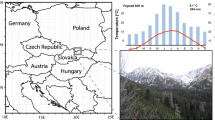Abstract
The larch bud-moth cycle has been observed in the sub-alpine larch-cembran pine forests 16 times since 1850. Infestation is easily recognized by the characteristic red-brown discoloration of the larch crowns due to the wasteful feeding of the bud moth larvae. The heaviest defoliation recurs at intervals of 8.47±0.27 (SE) years, and the larval density per kilogram of larch branches varies more than 10000-fold over four or five generations. The basic regulatory mechanism for this cycle is the induced change in food quality for the two or more subsequent larval generations. Defoliation functions as a negative feedback mechanism acting on larval density. In 1989 local discoloration in the Upper Engadine valley was observed in the usual first focus. In 1990 and 1991, however, instead of the expected widespread defoliation damage, larval densities decreased drastically. Based on extensive field data collected from 1961 to 1991 on the development and the survival of the bud moth (Zeiraphera diniana Gn.) and the phenology of the host, Larix decidua L., this paper shows the effect of weather on survival in the egg stage and on the coincidence of larval hatching with the sprouting of the larch. It is shown that the winter and spring weather conditions in 1989–1991 were conducive to unusually high egg mortality. Since these conditions occurred in three successive generations, population growth was effectively reduced and the cycle collapsed prematurely. Thus the rather persistent cyclicity of the larch-larch bud-moth system was disturbed by weather conditions with a very low probability of occurrence, but due to the inherent high resilience of the system, the next population peak with visible defoliation is expected to occur 1996/1997, provided that the weather conditions return to the climatic standard.
Similar content being viewed by others
References
Auer C (1961) Ergebnisse zwölfjähriger quantitativer Untersuchungen der Populationsbewegung des Grauen Lärchenwicklers Zeiraphera griseana Hübner (=diniana Guenée) im Oberengadin (1949–1960). Eidg Anst Forstl Versuchswes Mitt 37:173–263
Auer C (1975) Jährliche und langfristige Dichteveränderungen bei Lärchenwicklerpopulationen (Zeiraphera diniana Gn.) ausserhalb des Optimumgebietes. Mitt Schweiz Entomol Ges 48:47–58
Auer C (1977) Dynamik von Lärchenwicklerpopulationen längs des Alpenbogens. Eidg Anst Forstl Versuchwes Mitt. 53:71–105
Baltensweiler W (1964) Zeiraphera griseana Hübner (Lepidoptera: Tortricidae) in the European Alps. A contribution to the problem of cycles. Can Entomol 96:792–800
Baltensweiler W, Fischlin A (1979) The rôle of migration for the population dynamics of the larch bud moth, Zeiraphera diniana Gn. (Lep. Tortricidae). Mitt Schweiz Entomol Ges 52:259–271
Baltensweiler W, Fischlin A (1988) The larch bud moth in the Alps. In: Berryman A (ed) Dynamics of forest insect populations. Plenum Press New York, pp 331–351
Bassand D (1965) Contribution à l'étude de la diapause embryonnaire et de l'embryogenèse de Zeiraphera griseana Hübner (=Z. diniana Guenée) (Lepidoptera: Tortricidae). Rev Suisse Zool 72:429–542
Benz G (1974) Negative Rückkoppelung durch Raum- und Nahrungskonkurrenz sowie zyklische Veränderung der Nahrungs-grundlage als Regelprinzip in der Populationsdynamik des Grauen Lärchenwicklers, Zeiraphera diniana (Guenée) (Lep. Torticidae). Z Angew Entomol 76:196–228
Gower ST, Richards JH (1990) Larches: Deciduous conifers in an evergreen world. BioScience 40:818–826
Graf E (1974) Zur Biologie und Gradologie des Grauen Lärchenwicklers, Zeiraphera. diniana Gn. (Lep, Tortricidae), im schweizerischen Mittelland. Z Angew Entomol 76:233–251; 347–379
Schweingruber FH (1979) Auswirkungen des Lärchenwicklerbefalls auf die Jahrringstruktur der Lärche. Schweiz Z Forstwes 130:1071–1093
Author information
Authors and Affiliations
Rights and permissions
About this article
Cite this article
Baltensweiler, W. Why the larch bud-moth cycle collapsed in the subalpine larch-cembran pine forests in the year 1990 for the first time since 1850. Oecologia 94, 62–66 (1993). https://doi.org/10.1007/BF00317302
Received:
Accepted:
Issue Date:
DOI: https://doi.org/10.1007/BF00317302




